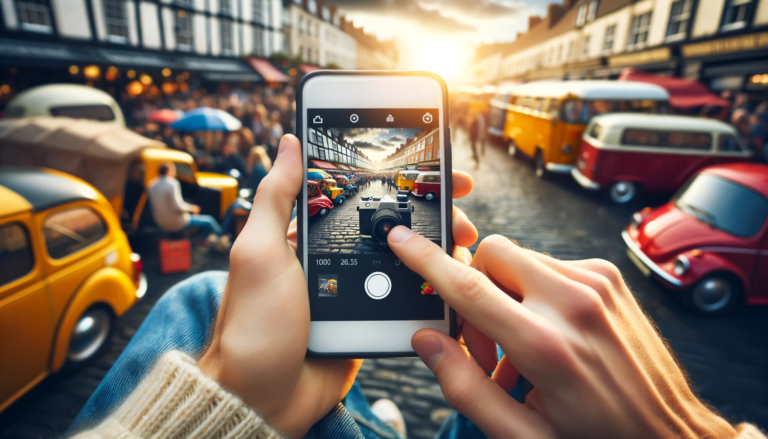In the vibrant world of fashion, Instagram has emerged as a pivotal player, reshaping how brands connect with their audience and altering the landscape of style and marketing. This digital platform has not only revolutionized the fashion industry but also redefined the way we perceive fashion trends and branding. In this comprehensive blog post, we delve into the multifaceted relationship between Instagram and the fashion industry, exploring how this social media giant has become an indispensable tool for fashion brands and influencers alike.
Introduction: Instagram and the Fashion Industry

In the ever-evolving realm of fashion, Instagram stands as a testament to the power of digital innovation. It’s a platform where creativity meets commerce, a stage where trends are set, and a community where brands and consumers engage in an unprecedented manner. This section introduces the profound impact of Instagram on the fashion world, setting the stage for an in-depth exploration of its influence.
The Transformative Power of Instagram
Instagram’s entry into the fashion industry was not just another digital trend; it was a game-changer. The platform has provided fashion brands, big and small, with a direct line to their audience, offering a visual storytelling medium that’s both engaging and personal. Instagram has blurred the lines between high fashion and street style, giving everyone a voice in the fashion dialogue.
Bridging the Gap: Instagram and Consumer Connection
The direct connection that Instagram fosters between fashion brands and their audience is unparalleled. It’s a two-way street of communication where feedback is immediate, and engagement is real-time. This connection has led to a more democratized fashion industry, where consumer preferences play a significant role in shaping trends.
Historical Context: Before and After Instagram and the Fashion Industry

To appreciate Instagram’s impact on the fashion industry fully, it’s essential to understand the landscape before its advent. This section will provide a historical overview of the fashion industry pre-Instagram and contrast it with the post-Instagram era.
Fashion Marketing: Then and Now
Before Instagram, fashion marketing was predominantly driven by traditional media such as print ads, fashion shows, and celebrity endorsements. The digital revolution, spearheaded by Instagram, has shifted this paradigm towards more interactive and consumer-driven marketing strategies.
Table: Marketing Shifts in Fashion: Instagram and the Fashion Industry
| Aspect | Pre-Instagram Era | Instagram Era |
|---|---|---|
| Primary Medium | Print Ads, Fashion Shows | Social Media, Digital Campaigns |
| Audience Engagement | Limited Interaction | High Interaction, Direct Feedback |
| Marketing Reach | Geographically Limited | Global Reach |
The Rise of Instagram: A Timeline
Instagram’s journey in the fashion industry is marked by key milestones that have significantly influenced how fashion is marketed and perceived. From the launch of Instagram Stories to the introduction of shoppable posts, each feature has added a new dimension to fashion marketing.
Instagram’s Role in Fashion Branding

In the world of Instagram, branding is not just about logos and slogans; it’s about storytelling and authenticity. This section explores how fashion brands have leveraged Instagram to build their identities and connect with their audience.
Case Study: Fashion Brands Flourishing on Instagram
In the dynamic landscape of Instagram, several fashion brands have risen to prominence by effectively leveraging the platform’s unique capabilities. This expanded case study delves deeper into specific examples of fashion brands that have harnessed Instagram’s power to redefine their branding and connect with audiences globally.
- Gucci: A Blend of Heritage and Modernity
- Strategy: Gucci strikes a balance between showcasing its rich heritage and tapping into contemporary culture. The brand has mastered the art of storytelling by integrating its historical roots with modern design elements.
- Implementation: Through visually rich posts, collaborations with artists and influencers, and engaging Instagram Stories, Gucci has created a distinct brand image that resonates with both luxury consumers and the millennial demographic.
- Impact: Gucci’s Instagram strategy has not only enhanced its brand visibility but also contributed to significant growth in sales and customer engagement.
- Zara: Fast Fashion Meets Fast Content
- Strategy: Zara’s approach on Instagram focuses on showcasing its fast-fashion collections through high-quality imagery and rapid content updates, mirroring the brand’s quick turnaround in fashion trends.
- Implementation: Utilizing a mix of product shots, lifestyle images, and user-generated content, Zara keeps its Instagram feed fresh and relatable, encouraging frequent visits and interactions from followers.
- Impact: This strategy has helped Zara maintain its position as a leading fast-fashion brand, driving traffic to both its online and physical stores.
- Small Boutique Brands: Making a Big Impact
- Strategy: Smaller boutique brands have used Instagram to level the playing field, focusing on niche markets and creating highly targeted content.
- Implementation: By highlighting their unique stories, craftsmanship, and values, these brands have cultivated loyal communities. They often engage directly with their audience through comments and Instagram Live sessions.
- Impact: Many such brands have seen exponential growth in brand recognition and sales, illustrating the power of Instagram in democratizing fashion branding.
The Metrics Behind the Success

To quantify the success of these brands, we can look at several key metrics:
- Follower Growth: A steady increase in followers indicates growing brand popularity and reach.
- Engagement Rates: High levels of likes, comments, and shares signify strong audience connection and interest.
- Conversion Rates: The effectiveness of Instagram in driving sales, measured by tracking the traffic from Instagram to e-commerce platforms.
The Art of Instagram Branding

The key to successful branding on Instagram lies in understanding the platform’s unique dynamics. It’s about striking a balance between aesthetic appeal and authentic messaging. We’ll delve into strategies that have proven effective for fashion brands on this platform.
Quotes on Branding Strategies
“Instagram has transformed fashion marketing by making it more personal and immediate.” – Fashion Marketing Expert.
“The key to Instagram success is in creating a narrative that resonates with your audience.” – Brand Strategist.
Influencer Marketing in Fashion: The Instagram Catalyst

Influencer marketing has become a cornerstone of fashion promotion on Instagram, harnessing the power of popular figures to sway consumer preferences and trends. This section explores the role of influencers in the fashion industry and their impact on consumer behavior.
The Essence of Influencer Marketing
Influencer marketing involves partnering with individuals who have a significant following on Instagram. These influencers, ranging from celebrities to micro-influencers, have the power to affect the purchasing decisions of their audience through their endorsements, style, and lifestyle choices.
Influencers: The New Age Fashion Icons

- Redefining Celebrity: In the Instagram era, influencers are the new celebrities. They offer a more relatable and accessible form of celebrity endorsement, making them highly effective for fashion marketing.
- Authenticity and Relatability: Unlike traditional celebrities, influencers often share more personal and behind-the-scenes content, fostering a sense of authenticity and connection with their audience.
Impact on Consumer Behavior
- Driving Trends: Influencers play a critical role in setting and popularizing fashion trends. Their choices often become instant hits among their followers.
- Influencing Purchases: Influencer endorsements can directly influence consumer purchases, with followers often seeking to emulate the styles showcased by their favorite influencers.
List: Top 5 Fashion Influencers on Instagram

- Chiara Ferragni – Known for her unique style and engaging content, she has become a global fashion sensation.
- Aimee Song – A fashion blogger turned Instagram influencer, renowned for her trendsetting looks.
- Camila Coelho – Blending high fashion with everyday style, she has a massive global following.
- Gigi Hadid – A top model whose Instagram presence has a significant impact on fashion trends.
- Leandra Medine – Founder of Man Repeller, known for her quirky and unconventional fashion choices.
The Influencer Marketing Strategy
- Brand-Influencer Alignment: Successful influencer marketing relies on choosing influencers whose style and audience align with the brand’s image and target demographic.
- Authentic Partnerships: Authenticity is key. Partnerships should feel natural and not overly promotional, as followers value genuine recommendations.
Influencer Marketing: A Double-Edged Sword

While influencer marketing can be highly effective, it also comes with challenges. There is the risk of over-saturation and diminishing returns if influencer content is perceived as inauthentic or too promotional.
Influencer marketing on Instagram has redefined fashion promotion, offering a platform for both established and emerging fashion brands to reach audiences in a more personal and impactful way. This strategy has not only changed how brands market themselves but also how consumers discover and engage with fashion.
Leveraging Instagram’s Features for Fashion Industry Success
Instagram offers a suite of features that fashion brands have creatively adopted to enhance their online presence and engage with their audience. This section examines how these features are utilized to maximum effect in the fashion industry.
Instagram Stories: A Tool for Real-Time Engagement
- Behind-the-Scenes Content: Fashion brands use Stories to share behind-the-scenes glimpses of photoshoots, fashion shows, and design processes, providing an insider view to followers.
- Limited-Time Offers and Announcements: The ephemeral nature of Stories is perfect for promoting time-sensitive offers, new collection launches, and exclusive announcements.
IGTV and Reels: Showcasing Fashion in Motion
- Fashion Shows and Tutorials: IGTV offers a platform for longer-form content like full fashion shows, makeup tutorials, and in-depth product reviews.
- Engaging Short-Form Content: Reels, with its short, snappy format, is ideal for creating engaging, easily consumable fashion content, such as quick style tips, outfit-of-the-day videos, and trend highlights.
Bolded Stats: The Impact of Instagram Features on Engagement
- Stories Engagement: Over 70% of Instagram users watch Stories daily, offering high engagement potential for fashion brands.
- Reels Effectiveness: Reels see 22% more engagement than standard video posts, making them a powerful tool for fashion marketing.
Consumer Interaction via Features
- Polls and Questions: Interactive features in Stories, like polls and Q&A sessions, allow brands to engage directly with their audience, gathering feedback and increasing engagement.
- Shopping Tags: The ability to tag products in posts and Stories simplifies the shopping experience, directly linking Instagram content with e-commerce.
Instagram’s diverse features offer fashion brands unique ways to engage with their audience, tell their stories, and showcase their products. Whether it’s through immersive Stories, informative IGTV content, or captivating Reels, these features have become integral to the fashion industry’s digital marketing strategies.
Consumer Engagement and Interaction: The Heart of Instagram’s Fashion Influence
In the world of Instagram, consumer engagement goes beyond mere viewership; it’s about creating a two-way conversation between brands and their audience. This section delves into how Instagram has transformed the dynamics of consumer interaction in the fashion industry.
Embracing User-Generated Content
- Fashion by the People: User-generated content (UGC) has become a cornerstone of Instagram marketing. When consumers share photos wearing a brand’s clothing, it not only serves as an authentic endorsement but also builds community.
- Hashtag Campaigns: Fashion brands often create unique hashtags to encourage UGC, resulting in a collaborative and interactive brand experience.
Feedback Loop: A New Era of Consumer Influence
- Immediate Responses: Instagram allows for real-time feedback from consumers, whether it’s through comments, likes, or direct messages. This immediate interaction helps brands gauge reactions to new products or campaigns swiftly.
- Incorporating Feedback: By actively listening to and incorporating consumer feedback, fashion brands can adjust their strategies and offerings to better align with audience preferences.
Table: Engagement Statistics for Top Fashion Brands on Instagram
| Brand | Average Likes per Post | Comments per Post | Engagement Rate |
|---|---|---|---|
| Brand A | 20,000 | 500 | 2.5% |
| Brand B | 15,000 | 300 | 2.0% |
| Brand C | 25,000 | 700 | 3.0% |
The Role of Instagram in Customer Loyalty
- Building Relationships: Regular interaction and engagement on Instagram help fashion brands build stronger relationships with their customers, fostering loyalty.
- Personalized Experience: Features like direct messaging and story replies allow brands to offer a more personalized experience, making customers feel valued and heard.
Through consumer engagement and interaction, Instagram has given fashion brands unprecedented access to their audience’s preferences and feedback, making it an invaluable tool for understanding and catering to consumer demands. This two-way dialogue has not only enhanced the customer experience but has also provided brands with critical insights for future strategies.
Instagram Shopping and E-commerce Integration: Transforming Fashion Retail
The integration of shopping features on Instagram has revolutionized the way fashion brands approach e-commerce. This section explores how Instagram has become a significant digital storefront for the fashion industry, streamlining the journey from inspiration to purchase.
The Emergence of Instagram Shopping: Instagram and the Fashion Industry
- Seamless Shopping Experience: Instagram Shopping allows users to purchase products directly from posts and Stories, creating a seamless shopping experience that blends social media engagement with e-commerce.
- Product Tags and Shoppable Posts: These features enable brands to tag products in their posts, making it easy for consumers to view product details and proceed to checkout without leaving the app.
Case Study: A Brand’s Journey from Instagram to E-commerce Success
- Brand X’s Strategy: Brand X, a contemporary fashion label, leveraged Instagram’s shoppable posts to showcase their collections and direct followers to their online store.
- Implementation: By integrating their product catalog with Instagram and using engaging visuals, Brand X created an immersive shopping experience that captured the attention of their target audience.
- Results: The brand witnessed a significant increase in online sales and customer engagement, attributing much of this success to its Instagram strategy.
Enhancing Customer Journey with Instagram Features
- Stories for Limited Offers: Fashion brands often use Instagram Stories to promote limited-time offers or exclusive product launches, driving urgency and immediate action.
- Explore Tab for Discovery: The Explore tab helps new customers discover fashion brands, expanding the brand’s reach beyond their existing follower base.
The Metrics Behind E-commerce Success on Instagram
- Conversion Rate: The percentage of users who purchase interacting with a shoppable post or story.
- Traffic Increase: Measuring the increase in website visits originating from Instagram.
- Sales Growth: The rise in sales figures is directly attributed to Instagram shopping features.
Instagram’s shopping and e-commerce features have provided fashion brands with an innovative platform to not only showcase their products but also directly drive sales. This development has blurred the lines between social media and e-commerce, offering a holistic digital shopping experience that caters to modern consumers’ needs.
Challenges and Criticisms: Navigating the Complexities of Instagram in Fashion
While Instagram has undeniably revolutionized the fashion industry, it’s not without its challenges and criticisms. This section explores the obstacles fashion brands face on the platform and the broader criticisms of Instagram’s influence on the industry.
Addressing the Challenges Faced by Fashion Brands
- Saturation and Visibility: With the overwhelming presence of fashion content on Instagram, brands often struggle to stand out and maintain visibility in a saturated market.
- Algorithm Changes: Instagram’s ever-evolving algorithm can impact a brand’s reach and engagement, making consistent visibility a challenge.
Criticisms of Instagram’s Impact on Fashion
- Unrealistic Beauty Standards: One of the significant criticisms is the perpetuation of unrealistic beauty standards through curated and edited images, leading to negative impacts on body image and self-esteem.
- Sustainability Issues: The promotion of fast fashion and consumerism on Instagram has raised concerns about environmental sustainability and ethical practices in the fashion industry.
Quotes from Critics and Industry Responses
“Instagram has created a culture of comparison and unrealistic beauty ideals.” – Social Media Analyst.
“We are aware of the environmental impact and are working towards more sustainable practices.” – Fashion Brand Representative.
The Balancing Act: Authenticity vs. Aesthetics
- Seeking Authenticity: There’s a growing demand for authenticity and transparency from fashion brands on Instagram, challenging them to balance aesthetic appeal with real, unfiltered content.
- Responding to Criticisms: Many brands are now addressing these criticisms by showcasing a more diverse range of models, adopting sustainable practices, and being more transparent about their production processes.
Navigating the complexities of Instagram in the fashion industry requires a careful balance between market demands, ethical considerations, and staying true to a brand’s identity. While the platform offers unparalleled opportunities for engagement and marketing, it also presents challenges that need to be thoughtfully addressed.
Future Trends and Predictions: Instagram’s Evolving Influence in Fashion
As we look ahead, it’s clear that Instagram will continue to play a pivotal role in the fashion industry. This section delves into emerging trends and offers predictions on how the relationship between Instagram and fashion might evolve in the coming years.
Anticipating Emerging Trends
- Augmented Reality (AR) Experiences: Expect to see more fashion brands embracing AR on Instagram, offering virtual try-ons and immersive experiences that enhance online shopping.
- Sustainable and Ethical Fashion: A growing trend towards sustainability and ethical practices will likely be more prominent on Instagram, with brands showcasing their efforts in this area.
Predictions on Instagram’s Future Role
- Increased E-commerce Integration: Instagram may further integrate e-commerce capabilities, possibly evolving into a primary shopping platform for fashion brands.
- Evolving Content Formats: As new features and technologies emerge, we can anticipate a shift in content formats, with a possible increase in interactive and dynamic content.
Bolded Words: Key Takeaways for Future Strategies
- Adaptability: Fashion brands must remain adaptable, embracing new features and trends to stay relevant on Instagram.
- Authenticity and Transparency: Authenticity will continue to be crucial, with brands needing to maintain transparency in their practices and messaging.
- Consumer-Centric Approach: Understanding and responding to consumer needs and feedback will be essential in shaping future Instagram strategies.
As we conclude this exploration, it’s evident that Instagram and the Fashion Industry are both transformative and multifaceted. The platform has not only changed how fashion is marketed and consumed but also how brands and consumers interact and influence each other. With continuous innovations and shifting trends, Instagram is poised to remain at the forefront of the fashion industry’s digital evolution.
Conclusion: Instagram and the Fashion Industry
Instagram’s impact on the fashion industry is a testament to the power of digital media in reshaping traditional industries. As a platform, it has offered fashion brands a new way to connect, engage, and sell to their audience, while also providing a space for consumers to express their style, discover new trends, and influence the industry. This symbiotic relationship highlights the importance of adaptability, creativity, and engagement in the digital age. As we move forward, it will be fascinating to observe how this relationship evolves, adapting to new technologies and changing consumer behaviors. Instagram has undeniably become a critical tool for the fashion industry, a trend that is likely to continue and grow in the future.
FAQs About Instagram and the Fashion Industry
How has Instagram changed the way fashion brands market themselves?
Instagram has allowed fashion brands to market themselves through visual storytelling, direct consumer engagement, and influencer collaborations, making marketing more interactive and personalized.
What role do influencers play in the fashion industry on Instagram?
Influencers drive fashion trends, promote brands through endorsements, and provide a relatable and accessible form of marketing that resonates with audiences.
Can small fashion brands benefit from Instagram marketing?
Absolutely! Instagram levels the playing field, allowing small fashion brands to reach a wide audience, showcase their unique style, and build a loyal community.
What are the best practices for fashion brands to increase engagement on Instagram?
Best practices include posting high-quality visual content, engaging with followers through comments and stories, using relevant hashtags, and collaborating with influencers.
How effective is Instagram’s shopping feature for fashion brands?
Instagram Shopping is highly effective, offering a seamless shopping experience that allows users to purchase directly from posts and stories, thereby increasing sales and customer convenience.
What challenges do fashion brands face on Instagram?
Challenges include staying visible in a saturated market, adapting to algorithm changes, and addressing criticisms related to sustainability and unrealistic beauty standards.
How important is authenticity for fashion brands on Instagram?
Authenticity is crucial. Consumers value genuine content and are more likely to engage with brands that showcase transparency and authenticity in their messaging.
What future trends are expected in the intersection of Instagram and fashion?
Future trends include increased use of augmented reality, a greater focus on sustainability, and the continuous evolution of content formats and e-commerce integration.
How can fashion brands measure success on Instagram?
Success can be measured through engagement rates, follower growth, conversion rates from Instagram to sales, and the overall impact on brand visibility and reputation.
Can Instagram marketing replace traditional fashion advertising?
While Instagram marketing is a powerful tool, it works best with other forms of advertising, offering a comprehensive approach to brand promotion and customer engagement.
Read More: Knows Kit



![Mastering Social Media Advertising: Strategies for Success[2024 Exquisite Guide] 21 Diverse social media advertising formats on platforms like Facebook, Instagram, and Twitter.](https://www.knowskit.com/wp-content/uploads/2024/01/the-dynamic-world-of-social-media-ads-768x439.png)



![Social Media: Essential Strategies for Digital Success [2024 Exquisite Guide] 25 Diverse individuals engaging with different social media platforms.](https://www.knowskit.com/wp-content/uploads/2024/01/the-global-influence-of-social-media-768x439.png)